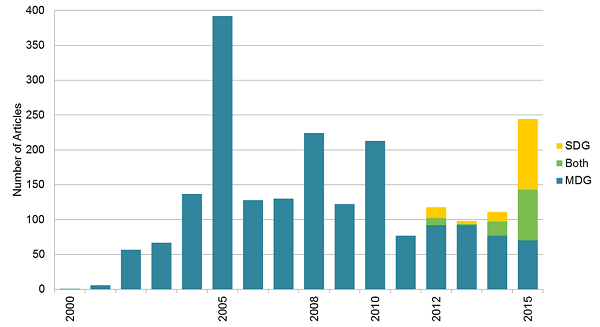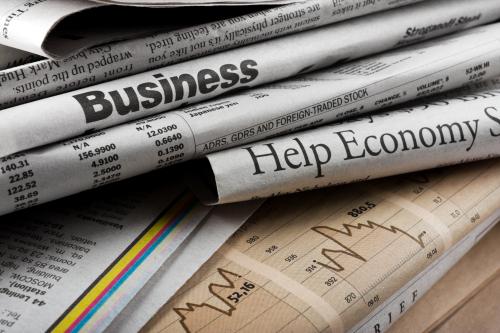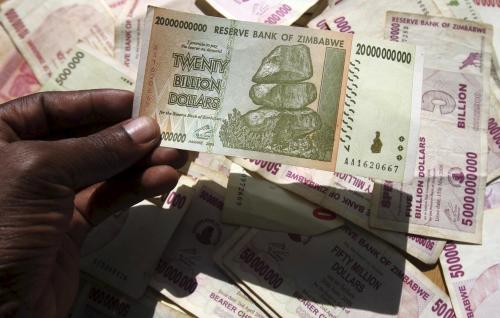The year 2015 was a big one for global development policy debates, marking the end of the Millennium Development Goals (MDGs) and the launch of the new Sustainable Development Goals (SDGs), also known as the “Global Goals.” But how much did major media pay attention?
Last September, Christine Zhang and I published a working paper that examined mentions of the MDGs across major English-language press and academic outlets from 2000 through 2014. We blogged highlights from the original paper here.
More recently, we updated some of the results to account for last year’s major MDG-SDG debates and events. Figure 1 adds 2015 newspaper data on the MDGs and also includes SDG mentions over the entire time period.
Figure 1: MDG and SDG mentions across 12 major newspapers, 2000-2015

Note: The 12 newspapers included are the Los Angeles Times (USA), The New York Times (USA), USA Today, and The Washington Post (USA), the Financial Times (UK), The Guardian (UK), The Independent (UK), The Daily Telegraph (UK), The Economist (UK), The Globe and Mail (Canada), the South China Morning Post (Hong Kong SAR), and The Sydney Morning Herald (Australia). Source: LexisNexis, authors’ calculations.
Here are three key takeaways from the new graph:
- First, by measure of article counts, 2015 was the second most prominent year for media coverage of the interlinked MDG-SDG agendas. But it only saw 62 percent as much coverage as the MDGs received in 2005, the year of the U.N. Millennium Project’s final report (January), the Gleneagles G-8 summit (July), and the U.N. World Summit (September).
- Second, global summits have consistently helped to ramp up media attention and debate. The years 2005, 2008, 2010, and 2015 all stand out as the top years for references—the same years in which the U.N. convened major summits linked to the MDGs and, in 2015, the SDGs. But U.N. summits do not guarantee attention. Notably, the 2012 Rio+20 summit that initially called for the SDGs did not cause a big splash in the media outlets examined.
- Third, recent years saw a discernible transition from MDG references to SDG references. By 2015, fully 41 percent of the relevant articles referenced only the SDGs, 30 percent mentioned both the SDGs and the MDGs, while only 29 percent mentioned the MDGs alone.
To be clear, these results do not provide a complete assessment of MDG-SDG media references in recent years, especially because social media and other new digital technologies now account for such a large share of public debate. (Note that the graph also excludes developing country newspapers, some of which we examined in the original working paper and similarly updated with 2015 results, but those do not make much difference to the overall story.) Thus one should not consider Figure 1 a definitive analysis of whether SDG advocates were successful in their public outreach campaigns last year. From a research perspective, the simple new-ness of “new media” renders long-term comparisons difficult. Restricting the data sample to print media offers one way to benchmark apples-to-apples coverage across the period of interest back to 2000.
That said, a seasoned media observer once suggested to me that traditional news outlets are inherently less connected to the bottom-up nature of emerging SDG conversations, and hence less likely to cover the SDGs accurately than new media channels in which user-generated content helps to drive the conversation. It’s an interesting hypothesis worth testing.
At a minimum, 2015 was a significant year for public conversations about the MDGs and SDGs, even if it might not have matched the peak year of 2005. An interesting line of research could seek to explain why. In any case, for analysts of the new SDGs, more sophisticated forms of global media benchmarking will undoubtedly be in order through to the new deadline of 2030.



Commentary
Was 2015 a PR success for the new Global Goals?
June 10, 2016